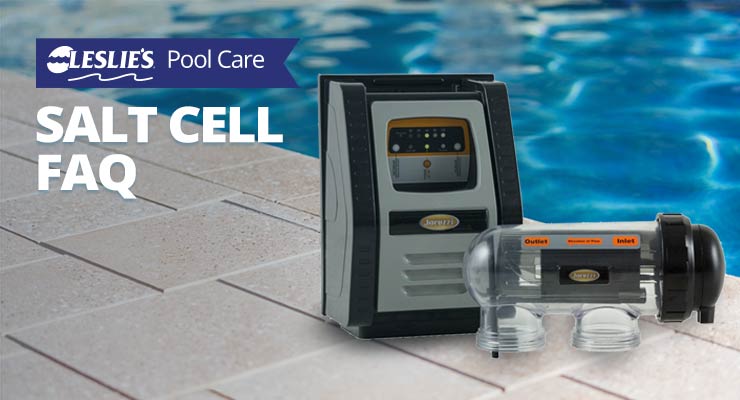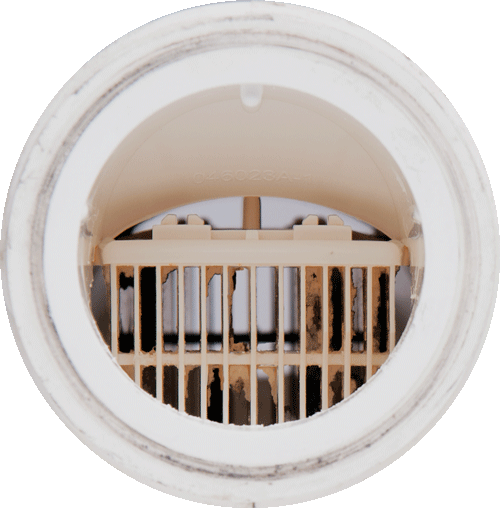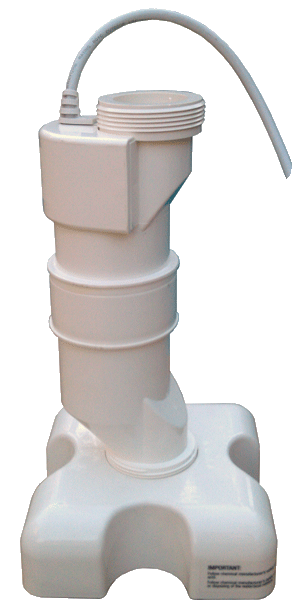
Salt Cell FAQ
Salt water chlorine generator systems are an increasingly popular method of sanitizing pool water, and for good reason. Not only do they provide a natural alternative to chlorine tablets, but some argue they may also provide a more comfortable swimming experience. If you’re one of the many pool owners who currently have a salt system, or if you’re thinking about switching to salt chlorination, you may have asked yourself about the cell at one point or another. In this post, we'll cover the 7 most common questions we hear about salt cells.
1. How Does a Salt Cell Work?
Salt cells produce chlorine through a process called electrolysis. To put it simply, the salt suspended in the water passes through electrically charged plates inside the salt cell. The resulting reaction splits the salt molecule and generates pure chlorine, which sanitizes the water.
2. Why Do Salt Cells Get Dirty?

Salt cells can develop white and flaky calcium scale buildup from a combination of factors. First, the plates generate heat, which can encourage calcium to fall out of solution and mineralize on surfaces. Second, salt water chlorine generators tend to increase pH levels in the pool, which can also promote increased scaling.
As with any other type of pool, maintaining proper water balance can help fend off issues with accumulating scale. Also check the condition of the cell regularly, according to manufacturer recommendations. For most salt cells, this is usually only a couple times per swim season. It’s important to keep track of scaling issues and keep the cell as clean as possible. Failure to do so will cause the cell to work harder than necessary, and ultimately leads to shortened cell life. When this happens, you'll need to purchase replacement cells more frequently.
3. Are Salt Cells Self-Cleaning?
The short answer is, not really. While some salt cells are equipped to reverse polarity, which helps reduce scale and calcium buildup on the plates, it won’t keep the plates completely clean. Monitoring cell cleanliness and removing scale buildup from the plates (when required) will ensure best performance over the long term.
4. How Often Should You Clean a Salt Cell?
The frequency of cleaning your salt cell depends on a lot of different factors, including how well you maintain proper water balance. Cell capacity in relation to pool volume can also have an impact, as a cell that's too small may have to work harder, which can lead to faster scale buildup. Generally speaking, most salt system manufacturers recommend cleaning the cell at least every 2–3 months while in use.
5. How Do You Clean a Salt Cell?
Before getting started, you’ll need to gather a few pieces of Personal Protective Equipment (PPE):

- Safety Glasses
- Gloves
- Closed-Toed Shoes
To best clean a salt cell, we recommend using a salt cell cleaning stand. Use one specifically designed for the model of cell you wish to clean. This will ensure that one end of the cell is completely supported and closed off to aid in the cleaning process. If you are unable to locate a suitable cell stand, a clean and sturdy plastic bucket will suffice.
- Disconnect the power, and remove your salt cell from the pool lines.
- Spray the plates inside the cell with a garden hose and spray nozzle to remove any loose debris.
- Get a clean, suitable container, and prepare a solution of muriatic acid and water, according to manufacturer recommendations. Some manufacturers require one part muriatic acid to four parts water, but others require a more diluted solution of ten parts water. Some manufacturers may not recommend using acid at all — always refer to the user manual for precise instructions. Use extreme caution when handling muriatic acid, and wear appropriate PPE. For safety reasons, remember to always add the chemical (acid) to the water; never add the water to acid. As an alternative to muriatic acid, you can also use a product called Acid Magic, which is safer and easier to handle.
- With the cleaning solution prepared, you’re now ready to soak the cell plates. Start by attaching the cell stand (mentioned above) to one end. Slowly pour the diluted solution into the top of the cell until the plates inside are completely submerged.
- Allow the solution inside the cell to soak for 2-5 minutes. Depending on the severity of the build-up, it may take a little longer. In those cases, let it soak for 10-15 minutes, or until the bubbles stop.
- Properly dispose of the used solution, rinse the cell out with clean water, and inspect the plates inside the salt cell. If you can’t see through all the gaps between the plates from inside the cell, repeat the process as necessary.
Important: Never use any sort of metallic instrument (screwdriver, pipe cleaner, pick, etc.) to scrub or scrape away debris from the plates inside the cell. Doing so can cause irreversible damage to the plates inside your salt cell.
6. What Size of Salt System Should I Use?
All salt cells are designed to produce enough chlorine to treat a specified pool volume, which is often listed on the product packaging. In most cases, cell sizes range between 15,000 and 40,000 gallons. The best bet is to purchase a salt system that is sized to handle more gallons than what you actually have in your pool. For starters, this will prevent your cell from working at full capacity all the time, which helps increase the longevity of the salt cell. But more importantly, a larger salt system means it can keep up with the chlorine demand in your pool, no matter the situation.
7. How Long Does a Salt Cell Last?
The average life of a salt cell can range anywhere from 3–7 years, depending on water chemistry, product quality, frequency of use, and how well you maintain the cell and keep it clean. The harder it has to work, the more often you'll have to replace the cell. Salt cells can fail in less than a year if they are not properly cared for. This is why it’s so important to routinely check and clean the cell while in use. To further prolong its lifespan, use a winter or “dummy” cell during the cooler off-season months. Salt cells can’t work as efficiently during cooler weather, anyway, so putting it in storage over the winter will keep it from overworking, and thus extend the life of your salt cell.
8. Why Do Salt Cells Fail?
As we mentioned above, salt cells fail for a few different reasons, but the main reason is a lack of proper maintenance. It is very important to check the cell regularly for excessive buildup, and maintain a regular cleaning schedule. Doing this ensures excess calcium doesn’t become caked on the metallic plates. Another common cause of salt cell failure is improper water balance. Be sure to test your pool water regularly, paying extra close attention to things like Total Alkalinity, pH, and Calcium Hardness. Don't run the cell in cooler weather, and disconnect it from the plumbing when freezing temperatures are in the forecast.
9. How Can I Get the Most Out of My Salt System?
To get the best use from your salt cell, there are many tips and tricks available. But really, it all boils down to routine care and maintenance. Cleaning the salt cell regularly is the best way to ensure the most efficient chlorine production. Leslie’s Stain & Scale Prevent helps keep the calcium in suspension in the water, reducing the likelihood of scale to form on pool surfaces. This, as you’ve probably deduced already, helps prevent your salt cell from getting dirty as quickly. Keep your water properly balanced, especially when it comes to pH and Calcium Hardness. Finally, make sure your salt cell isn’t working too hard. Your salt system should be properly sized (or even oversized) for the pool, which will allow the cell to last longer.
If you have more questions about salt systems or are curious about what’s involved with converting a pool to salt, start by checking out our blog posts on salt water pool systems. If you still have questions, we’re here to help! Call or stop by your local Leslie’s store to speak with one of our friendly pool experts.